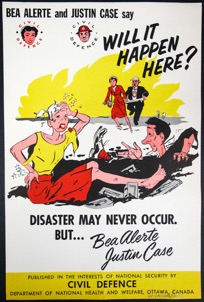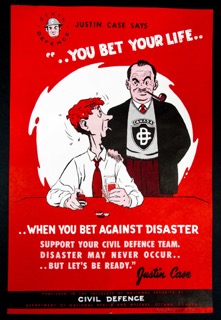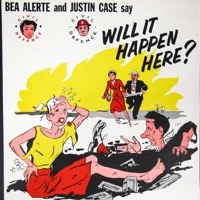Lessons from Bea Alerte and Justin Case (Sara Matthews - War and Society)
Dr. Sara Matthews is a member of the LCSC War and Society collective. Her work is interdisciplinary, and one of its focusses is the relationship between visual culture and martial politics.
Animating the Archive: Cold War Civil Defence and Public Pedagogy, is an interdisciplinary, collaborative research project between Wilfrid Laurier University and The Diefenbunker: Canada’s Cold War Museum. The project aims to shed light on an unexplored aspect of Canada’s Cold War history - civil defence education and its relationship to nation building. A strategy of Cold War defence familiar to many in the West through the animated “duck and cover” television campaigns produced for the American public during the early 1950’s, civil defence education was also integral to the project of sovereignty in Canada. Now commonly referred to as emergency preparedness, programs for civil defence have recently expanded as governments perceive new threats to national security, including those instantiated by climate change, cyberwarfare and global pandemics. In Canada, the history of civil defence education has yet to be systematically documented and studied. Led by Sara Matthews (Global Studies) and Gohar Ashoughian (University Librarian) and supported by a SSHRC Partnership Engage Grant, the project adopts a digital humanities approach to collections preservation and management, mobilizing research knowledge via a digital museum portal. We present a short excerpt from a current digital museum capsule under development: the story of Canadian civil defence propaganda through the cartoon characters Bea Alerte and Justin Case.

Selling war on the home front
“Will it happen here?” was the question posed to Canadians in this civil defence propaganda poster commissioned in the early 1950’s by the Information Service of the Department of National Health and Welfare. The poster depicts the cartoon mascots of Civil Defence Canada - Bea Alerte and Justin Case, engaged in a civilian rescue exercise in the aftermath of what appears to be a bombing. One of fourteen images created as part of a public advertising campaign that aimed to convince Canadians of their responsibility to participate in civil defense activities, the poster was printed in both French and English. In parallel with the rapid expansion of mass communication in the early 20th century, propaganda was popularized as a communicative practice that could influence public opinion. One way to “sell” the industrial revolution was through marketing and the visual strategies it deployed. And as the Canadian government soon realized through their relationships with the newly burgeoning advertising industry, propaganda was also a good way to sell war.

Sources: Source: Diefenbunker Museum Collection, “Will It Happen Here,” Poster, 1950’s. 2010A/00A/009C; Diefenbunker Museum Collection, “You Bet Your Life,” Poster, 1950’s. 2010A/00A/009AC.
[1] B. Bray, “From flag-waving to pragmatism: Images of patriotism, heroes and war in Canadian World War II propaganda posters,” Material History Review 42 (Fall 1995): 75-86, 75.
[2] “Victory Loans and War Savings,” Wartime Canada, accessed July 25, 2021, https://wartimecanada.ca/categories/victory-loans-war-savings.
[3] Bray, 76.
This material was developed by project RA Margrethe McKoen and Sara Matthews
